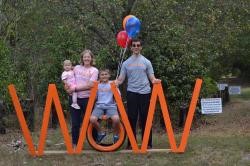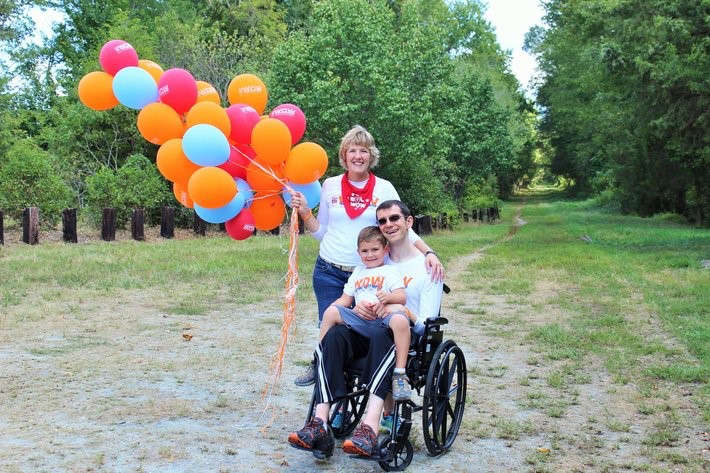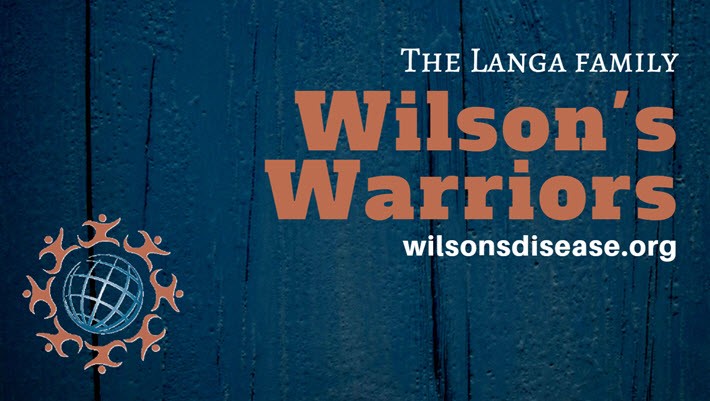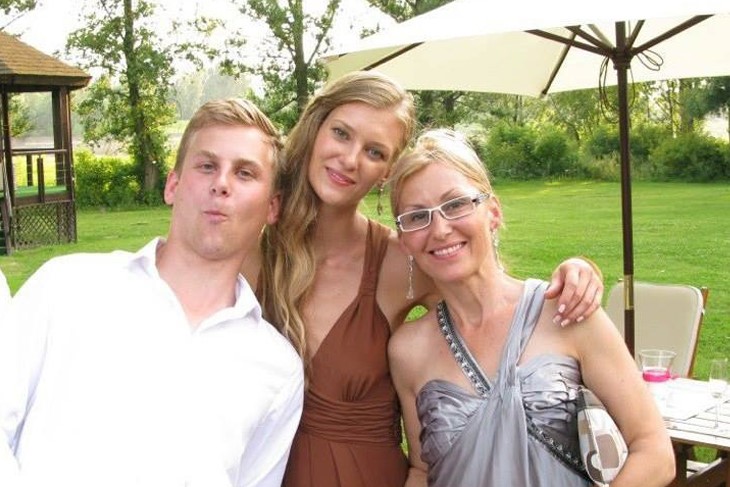
Langa Family
Thank you for visiting our Langa Family Big WOW page!! To our new supporters, hello (!!) and please read our story (further below) about how Wilson’s Disease (WD) has greatly impacted our lives over the last 10 years. To our supporters and attendees of previous years’ Big WOWs (hello to you, too!!), unfortunately, due to COVID-19 we are not holding an event that includes food, beverages, speakers and activities as we have in prior years. The national committee has gone fully virtual for the event this year; however, we have decided on the below for those that are interested:
The Langa Family with the help of the Friends of the Dahlgren Railroad Heritage Trail (DRHT) will have a small, informal walk on the Dahlgren Railroad Heritage Trail located at 10431 Bloomsbury Road in King George, Virginia to raise awareness for Wilson’s Disease. (For more information on the DRHT, please visit www.dahlgrentrail.org). The informal walk will be held on Saturday, October 3, 2020 at 1:00 p.m. Please remember to bring and WEAR YOUR MASK. We will also keep social distancing as a priority. No restroom facilities will be available at the trail. Donations will not be accepted in person at the walk. All donations towards Wilson’s Disease should be made via this page. We appreciate your assistance in this as we all do our part not to spread COVID-19.
Please click the donate button (to the right) to donate and support the fight against Wilson’s Disease. All funding will go towards the WD Patient Registry. “The Patient Registry creates a framework for advances in diagnosis, treatment and potential cures for the disease. Not only will the current generation of Wilson’s Disease patients benefit , but this registry will serve as a roadmap for future generations to come.” Please visit www.wilsonsdisease.org for more information. Please note that we will be accepting donations throughout the month of October. The donations link will be deactivated at 11:59p.m. on 10/31/2020.
OUR STORY:
For the past 10 years, Constantin Langa (now 37 years old) has been struggling with Wilson Disease (WD). Constantin’s symptoms started when his son Traian was only 3 months old, and his wife, Nichole, and him were just learning how to be new parents.
Some of Constantin’s first symptoms included excess saliva, toe and hand cramps, tongue and body tremors, dystonia, slurred speech, and balance loss (most all of which, he still struggles with today). It took him and his family 6 months from the start of his serious symptoms to get a diagnosis. By many measures though, they consider themselves very fortunate to have gotten a diagnosis within that timeframe, especially when others in the WD community were wrongly diagnosed or it took even longer for them to get a diagnosis. It was a very traumatic period for his family, as Constantin, a healthy and successful man, was falling apart, and his wife was taking care of a new baby. That “baby” (Traian) is now 10 years old, and Constantin and his wife were blessed with the birth of their second child (eight years later), a beautiful healthy girl named Adina, who is now 2 years old.
Part of the reason Constantin is a survivor is because he was diagnosed “early” enough to catch the fatal onset of the disease (although genetic testing at birth would have been the most ideal solution). However, getting a diagnosis was no easy matter. His family ran from doctor to doctor, and every time the doctors were either baffled, told them what Constantin didn’t have, or they were provided a wrong diagnosis. The first diagnosis they received was anxiety and depression, but they never gave up searching for answers because that just didn’t seem correct. His family knew that there was something more going on. It wasn’t until he took an MRI, and the neurologist saw the “panda face” that Constantin was finally on the path toward a diagnosis. The MRI, plus lab and genetic testing, and the discovery of Kayser-Fleischer Rings in his eyes solidified the diagnosis. Thanks to a doctor at Johns Hopkins and assistance from a WD Center of Excellence doctor at Yale, they had an answer.
Over this period of about 6 to 8 months, the neurological manifestations of WD took Constantin suddenly from a very healthy, active lifestyle and holding a full-time job in Washington, D.C. to completely debilitating neurological effects of not being able to perform any basic function without assistance. Constantin’s symptoms greatly worsened 3 weeks following the start of the chelation therapy medication. The doctors tried to save his liver by getting as much copper out of his body as quickly as possible. As a result, his neurological system was compromised.
Ten years into this WD journey, daily life is still a struggle and Constantin still requires 24-hour assistance from caregivers and family. However, his determination to get better means that even though he can’t attend the regular therapies (aquatic, modified yoga, neurofeedback, acupuncture, acupressure, speech, etc.) he used to prior to COVID-19 (which has resulted in additional neurological challenges for him) he continues to push and try to overcome. Even these many years later, they are defying the odds and continue to see improvements.
Our hope is to raise awareness for WD, so that we can prevent future generations from the same devastating situation. Early diagnosis and treatment is the key! Thank you for supporting us and the WD community as we work together to better the lives of our fellow human beings!! Stay safe out there.
With Love, The Langa Family

Langa Family
For the past seven years, my sweet husband (Constantin, now 34 years old) has been struggling with Wilson Disease (WD). Constantin’s symptoms started when our son Traian was only 3 months old, and we were just learning how to be parents.
Some of Constantin’s first symptoms included excess saliva, toe and hand cramps, tongue and body tremors, dystonia, slurred speech, and balance loss. It took us 6 months from the start of his serious symptoms to get a diagnosis. By many measures though, we consider ourselves very fortunate to have gotten a diagnosis within that timeframe, especially when we have heard the plight of others in the WD community. It was quite traumatic at the time though watching the healthiest person I knew, literally fall apart, while I was trying to care for our baby…
Part of the reason Constantin is a survivor is because he was diagnosed “early” enough to catch the fatal onset of the disease (although genetic testing at birth would have been the most ideal solution). However, getting a diagnosis was no easy matter. We ran from doctor to doctor, and every time the doctors were either baffled, told us what Constantin didn’t have, or we were provided a wrong diagnosis. The first diagnosis we received was anxiety and depression, but we never gave up searching for answers because that just didn’t seem correct. I, along with my in-laws, knew that there was something more going on. It wasn’t until he took an MRI, and the neurologist saw the “panda eyes” that we were finally on the path toward a diagnosis. The MRI, plus lab and genetic testing, and the discovery of Kayser-Fleischer Rings in his eyes solidified the diagnosis.
Over this period of about 6 to 8 months, the neurological manifestations of WD took my husband suddenly from a very healthy, active lifestyle and holding a full time job in Washington, D.C. to completely debilitating neurological effects of not being able to perform any basic function without assistance. Constantin’s symptoms greatly worsened 3 weeks following the start of the chelation therapy medication. The doctors tried to save his liver by getting as much copper out of his body as quickly as possible. As a result, his neurological system was compromised.
Seven years into this WD journey, daily life is still a struggle and Constantin still requires regular assistance from caregivers, family and me. However, his determination to get better means he attends regular therapy (aquatic, modified yoga, neurofeedback, acupuncture, acupressure, speech, etc.) and his many bumps, cuts and bruises are marks of him pushing his limits to overcome. Even these many years later, we are defying the odds and continue to see improvement, although it’s truly a game of patience.
Our hope is to raise awareness for WD, so that we can prevent future generations from the same devastating situation. Early diagnosis and treatment is the key!

Langa Family
For the past eight years, Constantin Langa (now 35 years old) has been struggling with Wilson Disease (WD). Constantin’s symptoms started when his son Traian was only 3 months old (he is eight now!), and his wife, Nichole, were just learning how to be parents. With their “never give up” attitude, however, Constantin and his wife were blessed with the birth of their second child, a beautiful healthy girl, named Adina in April of this year.
Some of Constantin’s first symptoms included excess saliva, toe and hand cramps, tongue and body tremors, dystonia, slurred speech, and balance loss. It took him and his family 6 months from the start of his serious symptoms to get a diagnosis. By many measures though, they consider themselves very fortunate to have gotten a diagnosis within that timeframe, especially when others in the WD community were wrongly diagnosed or took even longer to get a diagnosis. It was a very traumatic period for his family, as Constantin, a healthy and successful man, was falling apart, and his wife was taking care of a new baby.
Part of the reason Constantin is a survivor is that he was diagnosed “early” enough to catch the fatal onset of the disease (although genetic testing at birth would have been the most ideal solution). However, getting a diagnosis was no easy matter. His family ran from doctor to doctor, and every time the doctors were either baffled, told them what Constantin didn’t have, or they were provided with a wrong diagnosis. The first diagnosis they received was anxiety and depression, but they never gave up searching for answers because that just didn’t seem correct. His family knew that there was something more going on. It wasn’t until he took an MRI, and the neurologist saw the “panda face” that Constantin was finally on the path toward a diagnosis. The MRI, plus lab and genetic testing, and the discovery of Kayser-Fleischer Rings in his eyes solidified the diagnosis.
Over this period of about 6 to 8 months, the neurological manifestations of WD took Constantin suddenly from a very healthy, active lifestyle and holding a full-time job in Washington, D.C. to completely debilitating neurological effects of not being able to perform any basic function without assistance. Constantin’s symptoms greatly worsened 3 weeks following the start of the chelation therapy medication. The doctors tried to save his liver by getting as much copper out of his body as quickly as possible. As a result, his neurological system was compromised.
Eight years into this WD journey, daily life is still a struggle and Constantin still requires regular assistance from caregivers and family. However, his determination to get better means he attends regular therapy (aquatic, modified yoga, neurofeedback, acupuncture, acupressure, speech, etc.) and his many bumps, cuts and bruises are marks of him pushing his limits to overcome. Even these many years later, they are defying the odds and continue to see improvements.
Our hope is to raise awareness for WD, so that we can prevent future generations from the same devastating situation. Early diagnosis and treatment is the key!

Marie Lewin
Monica (daughter) was diagnosed with Wilson’s Disease at the age of 18, like many others it was a late diagnosis and many complications could have been avoided if there was more awareness to the condition and she was diagnosed earlier.
Donations
Your support allows the WDA to maintain this website, produce educational materials, support research, and hold meetings for people living with WD, their families, and the healthcare community.
Membership
As a member, you have the opportunity to communicate your concerns, share your experiences, learn about the most recent advances in Wilson disease treatment and research, and contribute to important decisions that need to be made so the WDA can be a strong patient advocacy group
WILSON DISEASE ASSOCIATION
Contact Us
- Toll Free: 866-961-0533
- Phone: 414-961-0533
Email: info@wilsonsdisease.org

